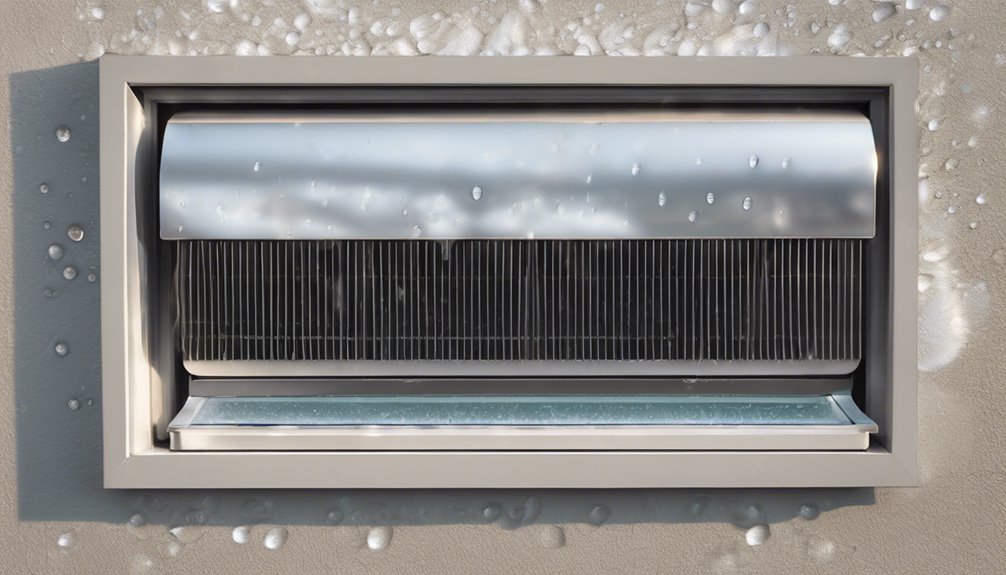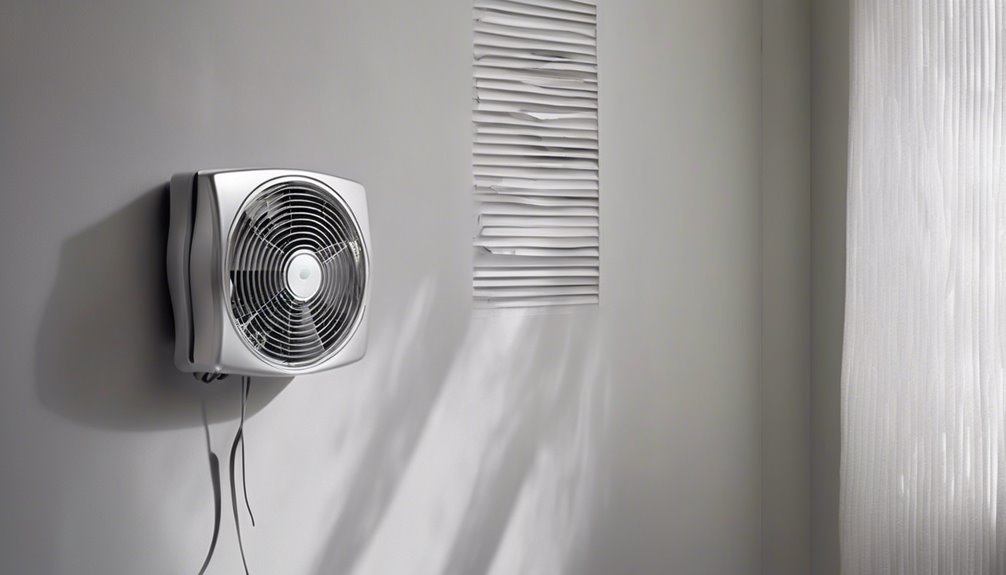To fix window AC water leakage, start by inspecting the drainage system to ensure it's working efficiently. Check the condensate flow, drain tube, and pan for blockages or damage. Clean or replace the air filter and condenser coils to improve airflow and reduce condensation. Make sure the unit is level and securely installed in the window. If issues persist, consider replacing the drain hose or pan. By tackling these common causes, you'll be well on your way to solving the problem – and taking a closer look at your AC's maintenance can reveal even more solutions.
Key Takeaways
- Identify and address underlying causes, such as clogged air filters and blocked airflow, to fix window AC water leakage issues.
- Inspect and maintain the drainage system, ensuring the condensate flow is unobstructed and the drain pan is sloped correctly.
- Clean or replace components, such as air filters and condenser coils, to improve air quality and reduce the risk of water leakage.
- Ensure proper window installation, including leveling the unit and securing the window frame, to prevent water collection and leakage.
- Regularly inspect and maintain the drainage system to prevent future leaks and consider replacing old or problematic window AC units.
Common Causes of Window AC Water Leakage
Many homeowners struggle with window AC water leakage, which can lead to water damage, mold growth, and even electrical issues.
You're not alone if you're dealing with this frustrating problem. One common cause is moisture buildup inside the unit. When warm air passes through the AC, it cools down, and the moisture in the air condenses into water.
Moisture buildup inside the unit is a common cause, occurring when warm air cools and moisture condenses into water.
If the AC can't handle this condensate, it can overflow and leak out. Another culprit is clogged air filters, which reduce airflow and cause the AC to work harder, resulting in excess condensation.
You might also be blocking airflow around the unit, which can exacerbate moisture buildup and lead to leakage. Identifying and addressing these underlying causes is key to fixing your window AC water leakage issue.
Checking the Drainage System
Your window AC's drainage system plays a crucial role in preventing water leakage.
It's essential to check the drainage design to ensure it's functioning correctly. You should verify that the condensate flow is unobstructed and that the drain pan is sloped correctly to allow water to flow freely.
Check the drain tube for kinks, blockages, or damage that could impede condensate flow. Make sure the tube is securely connected to the AC unit and the drain pan.
If you find any issues, correct them to ensure the drainage system is working efficiently. By doing so, you'll reduce the likelihood of water leakage and prevent further damage to your window AC.
Inspecting the Air Conditioner's Rear Drain
Now that you've ensured the drainage system is functioning correctly, it's time to inspect the air conditioner's rear drain. This crucial step in rear drain maintenance involves checking for blockages or clogs that might be causing water leakage. Start by locating the drainage hole, usually found at the back of the unit. Inspect the hole for any signs of blockage or debris.
| Step | Task | What to Look For |
|---|---|---|
| 1 | Locate drainage hole | Check for blockages or debris |
| 2 | Inspect drainage hole | Look for signs of clogging or corrosion |
| 3 | Check drain tube | Ensure it's securely connected and not kinked |
| 4 | Verify drain tube direction | Make sure it's pointing downwards for proper drainage |
Performing regular drainage hole inspection will help prevent water leakage issues in your window AC unit.
Cleaning the Air Filter and Condenser Coils
You'll next need to clean the air filter and condenser coils to ensure your window AC is running efficiently and not leaking water.
Start by checking the filter for dirt and debris, and give it a good cleaning or replacement if necessary.
Then, inspect the condenser coils for dust buildup, which can block airflow and cause issues.
Filter Cleaning Essentials
A clean air filter and condenser coils are crucial components of a well-functioning window AC unit, as they directly impact its performance and ability to cool the air efficiently.
You'll want to prioritize filter maintenance to ensure your air conditioner runs smoothly. A dirty filter can reduce air quality, making your indoor air stale and musty.
Check your filter monthly and clean or replace it as needed. Remove the filter from the AC unit, gently tap off excess dust, and wash it with mild soap and warm water. Let it dry completely before reinstalling it.
This simple step will improve air quality and help prevent water leakage issues.
Coil Dust Removal
Coil dust removal is a crucial step in maintaining your window AC unit's performance and preventing water leakage issues. Dust accumulation on the coils can reduce airflow, increase energy consumption, and even lead to water leakage. You can clean the coils by gently brushing off the dust with a soft-bristled brush or a vacuum cleaner. For more thorough cleaning, mix a solution of mild detergent and warm water, and soak the coils for 30 minutes before rinsing them with clean water.
| Coil Cleaning Methods | Effectiveness |
|---|---|
| Soft-bristled brush | 6/10 |
| Vacuum cleaner | 7/10 |
| Mild detergent and water | 9/10 |
| Compressed air | 8/10 |
| Coil cleaning brush | 8/10 |
Airflow Blockage Checks
Proper airflow is essential for your window AC unit to function efficiently and prevent water leakage issues.
You'll want to ensure that your unit has a clear path for air to flow in and out. Check your air filter and clean or replace it if it's dirty. A clogged filter can cause ventilation issues, leading to airflow obstructions that can cause your AC to leak water.
Also, inspect your condenser coils for dust and debris. Clean them gently with a soft brush or vacuum to remove any blockages.
Ensuring Proper Window Installation
You'll want to make sure your window AC unit is properly installed to prevent water leakage.
Start by ensuring the unit is level, as an uneven installation can cause water to collect and leak out.
Next, you'll need to secure the window frame and check the window seal for any gaps or cracks that could allow water to escape.
Level the Window Unit
A sloping window unit can be a recipe for disaster, as it allows water to collect and flow towards the interior of your home. To prevent this, you need to ensure your window unit is level. Check the window placement and AC alignment to ensure they're even. Use a spirit level to double-check the unit's position.
| Check | Action |
|---|---|
| Window frame | Ensure it's level and secure |
| AC unit | Verify it's aligned with the window frame |
| Shims or blocks | Use them to level the unit if necessary |
| Final check | Double-check the unit's position with a spirit level |
Secure the Window Frame
Your window frame serves as the foundation for your window AC, so it's essential to secure it properly to prevent water leakage.
A loose or poorly installed frame can cause water to seep in and leak out. To avoid this, you'll need to make some adjustments.
- Check the frame for any gaps or openings and seal them with weatherproofing strips.
- Make frame adjustments to ensure it's level and plumb.
- Verify that the window AC is properly seated in the frame.
- Double-check that all screws and bolts are tightened securely to prevent any movement.
Check the Window Seal
Now that the window frame is secure, it's time to inspect the window seal.
You'll want to check for any signs of wear, damage, or gaps that could be causing water to leak in. Use a flashlight and a soft brush to remove any dirt or debris that might be hiding defects.
Seal inspection methods include visually examining the seal for cracks or gaps, and performing a soap test to detect air leaks.
If you find any issues, consider replacing the seal with a new one made from a durable material like rubber or vinyl. Seal material options also include foam tape or adhesive-backed weatherstripping for a more temporary fix.
Dealing With Clogged Drain Hoses
Clogged drain hoses are a common culprit behind window AC water leakage.
To avoid this issue, you need to prioritize drain hose maintenance. Regularly inspect the hose for blockages, kinks, or damage.
Prioritize drain hose maintenance to prevent issues, regularly inspecting for blockages, kinks, or damage.
When inspecting the hose, look for signs of wear, such as cracks, brittleness, or rust.
- Check the hose for mineral buildup by disconnecting it from the AC unit and running water through it.
- Use a soft brush or cloth to clean out any debris or sediment.
- Inspect the hose's connection points for tightness and make sure they're secure.
- Consider replacing the hose if you notice any signs of damage or wear.
Replacing the Drain Pan or Water Tray
The drain pan or water tray is another common culprit behind window AC water leakage, as it can become clogged with debris and mineral buildup over time.
If you've checked the drain hose and it's clear, it's time to inspect the pan or tray. Check if it's made of a rust-prone pan material or has a tray design that's prone to clogging.
If so, consider replacing it with a rust-resistant or sloped tray design that allows water to flow freely. Remove any screws or clips holding the old pan or tray in place, then gently pull it out.
Clean the area before installing the new one, making sure it's securely fastened. This should fix the leakage issue and get your window AC running smoothly again.
Frequently Asked Questions
Can I Use a Dehumidifier to Reduce Window AC Water Leakage?
You can utilize a dehumidifier to reduce moisture in the air, which might alleviate window AC water leakage issues. By running a dehumidifier, you'll benefit from moisture reduction, creating a drier environment that may minimize condensation and leakage.
Will a Leaking Window AC Increase My Electricity Bill?
You're wondering if a faulty AC will hike your electricity bill. Yes, it will! A leaking window AC increases energy consumption, which directly impacts your bill, causing it to rise, so it's essential to address the issue promptly to avoid inflated costs.
Can I Fix a Window AC Water Leak Myself or Hire a Pro?
You can try fixing the leak yourself if you have basic DIY expertise, but if you're unsure, it's best to hire a pro for a thorough diagnosis to ensure the issue is resolved efficiently and effectively.
How Often Should I Clean My Window AC to Prevent Water Leakage?
You should clean your window AC regularly to prevent water leakage, ideally every 1-2 months, by checking and replacing the air filter, which helps reduce moisture buildup and ensures efficient air circulation.
Will a Window AC Water Leak Damage My Window or Wall?
You're right to worry, as water leakage from your window AC can cause significant damage. If left unchecked, water seepage can rot your window frame, leading to costly repairs or even structural issues, so it's essential to address the issue promptly.
Conclusion
You've finally identified and fixed the issue causing your window AC to leak water. By checking the drainage system, inspecting the rear drain, cleaning the air filter and condenser coils, ensuring proper window installation, dealing with clogged drain hoses, and replacing the drain pan or water tray if needed, you've taken the necessary steps to prevent future leaks. Now, enjoy the cool air without the mess and worry of water damage. Your window AC is working efficiently and effectively once again.



